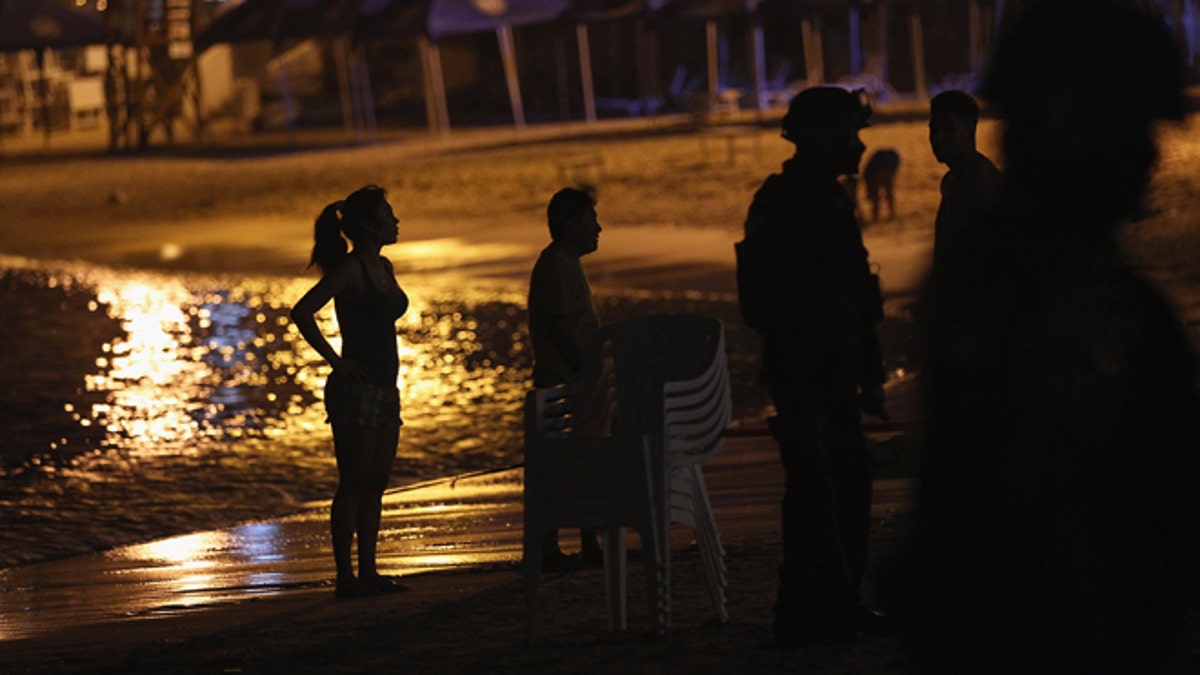
ACAPULCO, MEXICO - MARCH 04: Mexican tourists and soldiers stand look on at the site of a suspected drug-related execution on Acapulco's famous Caleta Beach on March 4, 2012 in Acapulco, Mexico. Drug violence has surged in the coastal resort in the last year, making Acapulco the second most deadly city in Mexico after Juarez. One of Mexico's top tourist destinations, Acapulco has suffered a drop in business, especially from foreign tourists, due to the violence. Toursim accounts for about 70 percent of the economy of Acapulco's state of Guerrero and 9 percent of Mexico's economy. (Photo by John Moore/Getty Images) (2012 Getty Images)
Mexico used to be the place where Americans went to relax, let their hair down and maybe go a little wild. Resort towns like Acapulco, Mazatlán and Cancún drew thousands of tourists – from blue-haired retirees to party-hungry college kids – thanks to their good weather, cheap living and their Laissez-faire attitude to debauchery.
Mexico’s ongoing drug war, however, has caused concern on both sides of the border that the escalating violence will turn on the tourist community – killing both the visitors and the cash flow that accompanies them.
With the vicious rape of six Spanish tourists in Acapulco, followed by the slaying of a Belgian businessman and widespread violence on the outskirts of Mazatlán, tourists have avoided some locales – particularly after the U.S. State Department issued dire warning to U.S. travelers in the region.
“Some places have been badly affected by the drug war,” said Peter Hakim, president emeritus of the Latin American think tank the Inter-American Dialogue in Washington D.C.
The 2000-plus miles of shared border between the two countries and international media attention of the drug war – especially the more sensational crimes like the Acapulco rapes – have kept many tourists from the U.S. from venturing south of the border.
This type of crime, especially the sensational type, always has a negative effect on tourism.
Acapulco became a national and international tourist destination in the 1960s and 1970s, with the construction of a number of hotels along the Pacific coast and the expansion of the city’s port. The laying of the road known as the Ruta del Sol in 1990s opened up easy transport from Mexico City to Acapulco.
During the last decade, Acapulco remained out of the drug war spotlight as former Mexican President Felipe Calderón and media attention focused on the violence in border cities such as Ciudad Juárez, Reynosa and Tijuana. Gun battles in the streets and the death of drug lord Arturo Beltran Leyva in 2009, however, helped ratchet the violence in Acapulco.
In August of 2011, five headless bodies were discovered in Acapulco, three of which were in the city's main tourist area.
“This type of crime, especially the sensational type, always has a negative effect on tourism,” said Christopher Wilson, a Mexico expert at the Woodrow Wilson International Center for Scholars in Washington, D.C.
Mazatlán – a city on the Pacific coast in the state of Sinaloa – has seen violence related to the drug war surround the city due in large part to the presence of Joaquín “El Chapo” Guzmán’s Sinaloa Cartel running rampant in the mountainous state.
“We’ve had a bad rap with the drug problem,” Frank Córdova, Sinaloa’s secretary of tourism, told Fox News Latino. “We didn’t do our job we didn’t protect the port.”
A number of infrastructure revitalizations, including a $60 million technology investment into the city’s main port, have led to a reduction in trafficking and violence in the city. City officials have also overhauled Mazatlán’s police force with the aim of freeing it from the corruption that has plagued local law enforcement throughout Mexico.
Córdova, formerly Sinaloa’s secretary of security, said that the state’s problem with drug cartels has focused mainly in the wilderness outside the city and that by-and-large Mazatlán has remained safe. The U.S. State department only warned against travel outside of the city and around 25,000 Americans reside in the city.
“This is like saying there is a violence problem in Miami when all the problems are in the Ozarks,” Córdova said. “It’s not happening in the city, but out in the mountains.”
Despite heightened levels of violence in some Mexican resort towns, international tourism actually rose in 2011 in Mexico – when the last count was taken - and the vast majority of violent acts were not directed at tourists.
Mexico’s tourism agency released new figures that showed the number of foreign travelers arriving by air in 2011 rose to 22.7 million, the most since the Bank of Mexico began keeping track in 1980. These figures come as an estimated 70,000 people died in violence related to the country’s ongoing drug war. An escalation in murders and other violent crimes arose soon after Calderón took office in 2006, when he declared an all-out military blitz on Mexico’s drug cartels.
The agency did report a 3 percent drop in air travel from the U.S. to Mexico, other tourists – particularly from Brazil, Russia, Peru and China – bolstered the uptick in visitors.
Experts argued that major cartels know their limits and don’t want to draw heat from federal or U.S. authorities.
“Organized crime and gangs in Mexico are trying not to draw attention to themselves,” Wilson said. “The more organized they are, the less interested they are in going after tourists. They operate like a business.”
Like travel anywhere, tourists visiting Mexico still should be wary of getting robbed or attacked as some smaller gangs and “lone wolf” criminals are still threats, Hakim said.
“There are the cartels, there are the smaller groups and then there are those criminals who feel they’re not making enough and need to take advantage of the tourists,” Hakim said. “These lone wolf criminals are the ones that pose a threat.”
